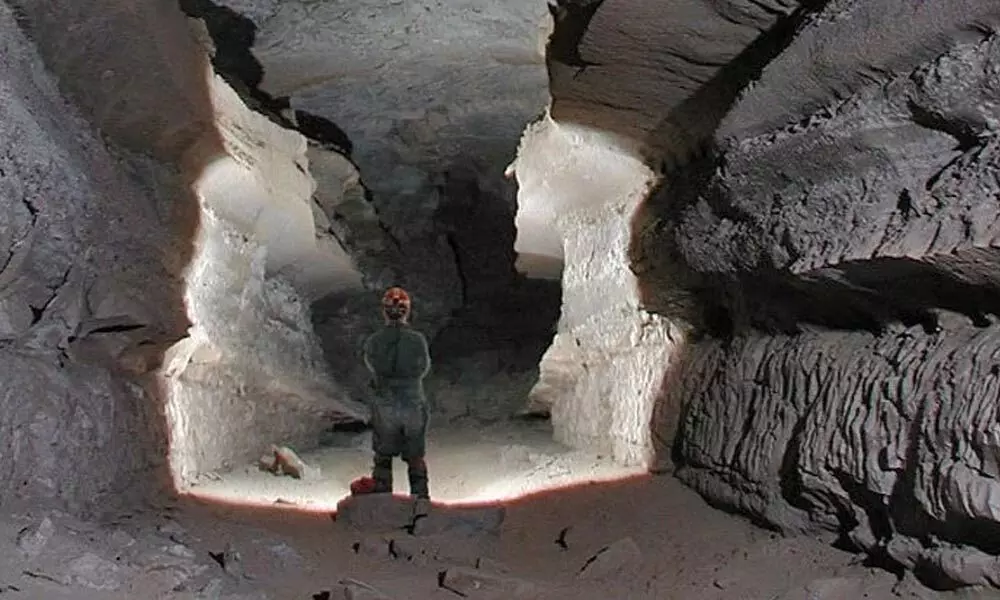Live
- A Guide to Temperature and Humidity Standards in Data Center Server Rooms
- Gadwal collector briefs on details of voters
- Jupally Krishna Rao takes part in Alampur rallu
- Bharath Prasad files 3rd Nomination
- Baisakh Month: A Time of Auspicious Beginnings and Sacred Festivals
- Oust BJD govt for overall development, says Shah
- Unveiling the Hidden Gems: Surprising Health Benefits of Garlic Peels
- Overcoming Sleep Struggles: A Comprehensive Guide to a Restful Night
- RTC bus hit the auto
- MLA Kuchukula Rajesh Reddy participated in the Birappa festival
Just In
Reports Shows World's Longest Cave System Expansion

Hans News Service | 19 Sep 2021 10:04 AM GMT

x
Reports Shows World's Longest Cave System Expansion
Highlights
- Surveyors spent hours mapping an extra 8 miles (13 kilometres) of passageways at Mammoth Cave National Park in Kentucky, setting a new record for world's longest known cave system.
- A Kentucky-based nonprofit organisation, and other locals, including members of the Central Kentucky Karst Coalition, worked together to map the cave system.
Surveyors spent hours mapping an extra 8 miles (13 kilometres) of passageways at Mammoth Cave National Park in Kentucky, setting a new record for world's longest known cave system.
According to the National Park Service, the passages in Mammoth Cave now stretch about 420 miles (676 kilometres) (NPS). That's about how far New York City and Raleigh, North Carolina is separated.The Cave Research Foundation (CRF), a Kentucky-based nonprofit organisation, and other locals, including members of the Central Kentucky Karst Coalition, worked together to map the cave system.
Karen Willmes, CRF's eastern operations manager, said in a statement published by the National Park Service on September 11, that many of the cave tours are long and difficult, requiring climbing, vertical exposure, squeezes, crawlways, water, and mud.
Cartographers put the data obtained on the cave expedition into a map after the excursion. Other people are helping out on the surface. They were thrilled to be a part of such a fantastic initiative for a world-class cave.
The Mammoth Cave system has grown before. With 65 miles (105 kilometres) of recorded passages, it entered the record books in 1969.
In September 1972, CRF cavers uncovered a link between the Mammoth Cave and the Flint Ridge systems during a 14-hour survey, bringing Mammoth Cave's total known distance to 144 miles (232 kilometers).According to the National Park Service, subsequent CRF surveys have added mileage to the Mammoth Cave system, including the finding of linkages between it and smaller caves like Proctor Cave, Roppel Cave, and Morrison Cave.
The Mammoth Cave system is a massive labyrinth generated by limestone erosion, a phenomenon known as karst topography in science and seen in other soluble rocks including marble and gypsum.
According to a blog post by the US Department of the Interior and the National Park Service, karst topography occurs when water from rain and rivers seeps underground through cracks, fractures, and holes and then travels far underground, slowly dissolving and shaping the soft underground bedrock into caves and other geologic features. More than 2 million people visit the cave system each year, which is home to 130 wildlife species, including 14 troglobites (cave-dwelling animals), such as the eyeless southern cavefish (Typhlichthys subterraneus).
The United Nations has designated Mammoth Cave National Park as one of only 13 natural U.S. sites as a World Heritage Site, praising the caves for their beauty.
Meanwhile, the world's longest underwater cave system is located in Quintana Roo, Mexico, on the Yucatán Peninsula. According to Live Science, researchers with the Great Maya Aquifer announced in 2018 that two previously known underwater cave systems have been linked, producing the bigger Sac Actun system, which currently measures 215 miles (347 kilometres) long.
More On

Next Story
More Stories
ADVERTISEMENT
© 2024 Hyderabad Media House Limited/The Hans India. All rights reserved. Powered by hocalwire.com






